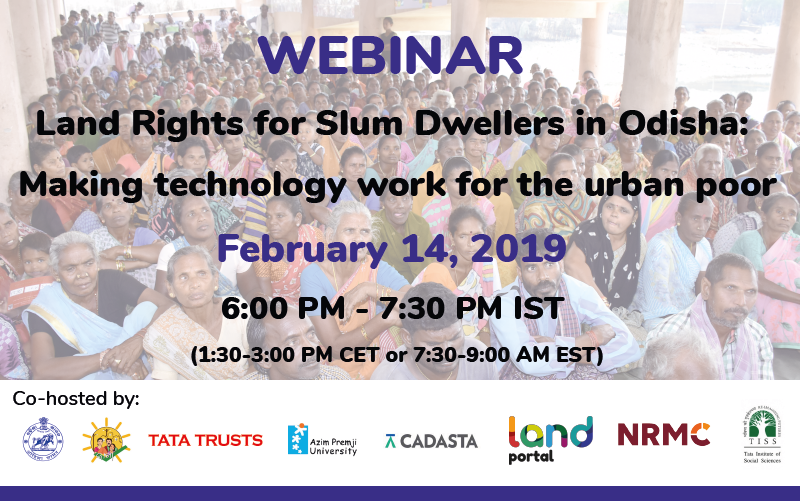Welcome and introduction from Narayana Gatty, Professor, Azim Premji University
Narayana:
It is my pleasure to welcome you to this timely and important webinar on Land Rights for Slum Dwellers in the East Indian State Odisha: Making technology work for the urban poor, which is co-organized by o-organized by the Government of Odisha, Tata Trusts, Azim Premji University, Cadasta Foundation, Tata Institute of Social Sciences (TISS) with support from the NRMC Center for Land Governance and the Land Portal Foundation.. It is my honor to moderate this forum.
Odisha is one of the major states of India, urbanizing at a fast rate. As per the 2011 census, while the total growth rate of population for the state over the past decade was 13.97%, it was 26.8% for the urban areas. Much of this high urban growth rate is due to the migration of poor people from rural to urban areas in search of better livelihood opportunities, and this also contributes to the growth of informal settlements or ‘slums’. This increasing slum population poses high demands on the urban local bodies to provide land for housing and basic services. Lack of legal land tenure has a detrimental impact on their overall quality of life. Without a certificate of residence, they are barred from getting loans for starting businesses, accessing basic services or finding a formal job.
In August 2017, Government of Odisha enacted landmark legislation the “Odisha Land Rights to Slum Dwellers, Act 2017” to enable identifying, securing and transferring of land rights to slum dwellers in all municipalities and Notified Area Councils (NACs). In all stages of the project execution, advanced technology was used to bring in ease of doing this accurately, create transparency in the process, remove discrepancies, reduce the dependency on human interventions and bring in speed in execution. While mapping was done through Unmanned Aerial Vehicles (drones), data collection was done through GIS and digital based applications, and the project was managed through digital networking. This is perhaps the first time that UAVs and other technologies are being used to create high-resolution maps of slums and a household database at such a large scale in India.
The objective of the webinar is to discuss this project, application of innovative technologies, processes and partnerships in the its execution and best practices followed in confering rights for slum dwellers.
Allow me to introduce our esteemed panelists:
- G. Mathi Vathanan, IAS, Principal Secretary, Housing & Urban Development Department, Government of Odisha
- Amita Girish Bhide, Professor and Dean, School of Habitat Studies, Tata Institute of Social Sciences
- Frank Pichel, Cadasta Foundation
- Shishir Dash, Lead- Urban habitat, Tata Trusts
This webinar will broadly cover the evolution and context of Land Rights Act 2017 in Odisha, the application of innovative technology and how this was done, partnership, capacity building and strengthening local institutions, and also good practices and research opportunities that have come out of these efforts.
We encourage participants to ask questions. Please use the questions feature to pose questions to the panelists. We will ensure that your questions are addressed in turn during the open discussion that follows.
Let me ask the first question to Mr. G Mathi Vathanan. What is the context and ultimate objective of the Act? Is the project limited to only provisions of land rights or also considering improvement of living standard of slum dwellers?






